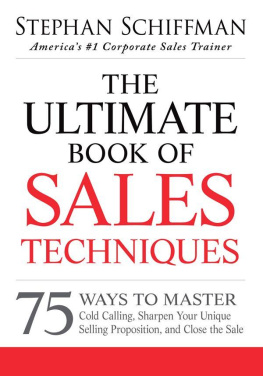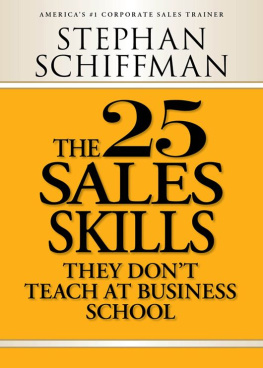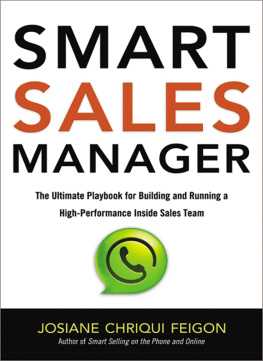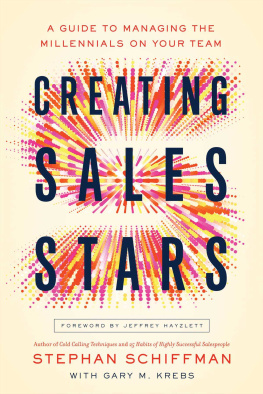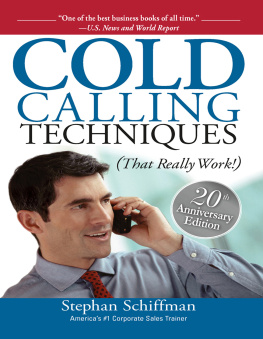Schiffman - Cold Calling Techniques
Here you can read online Schiffman - Cold Calling Techniques full text of the book (entire story) in english for free. Download pdf and epub, get meaning, cover and reviews about this ebook. year: 1987, publisher: F+W Media, genre: Business. Description of the work, (preface) as well as reviews are available. Best literature library LitArk.com created for fans of good reading and offers a wide selection of genres:
Romance novel
Science fiction
Adventure
Detective
Science
History
Home and family
Prose
Art
Politics
Computer
Non-fiction
Religion
Business
Children
Humor
Choose a favorite category and find really read worthwhile books. Enjoy immersion in the world of imagination, feel the emotions of the characters or learn something new for yourself, make an fascinating discovery.
Cold Calling Techniques: summary, description and annotation
We offer to read an annotation, description, summary or preface (depends on what the author of the book "Cold Calling Techniques" wrote himself). If you haven't found the necessary information about the book — write in the comments, we will try to find it.
Schiffman: author's other books
Who wrote Cold Calling Techniques? Find out the surname, the name of the author of the book and a list of all author's works by series.
Cold Calling Techniques — read online for free the complete book (whole text) full work
Below is the text of the book, divided by pages. System saving the place of the last page read, allows you to conveniently read the book "Cold Calling Techniques" online for free, without having to search again every time where you left off. Put a bookmark, and you can go to the page where you finished reading at any time.
Font size:
Interval:
Bookmark:

CALLING
TECHNIQUES
(That Really Work!)
ANNIVERSARY EDITION
SIXTH EDITION
America's #1 Corporate Sales Trainer

This book is dedicated to AFS.
I sometimes wonder how salespeople dealt with innovation 100 years ago. Did they see the telegraph and telephone as significant advances that would change the nature of sales? Did they jump on the new technology or were they afraid of it?
In many respects the introduction of the telephone and telegraph more than a century ago aren't really very much different than the introduction of e-mail and faxes in our time.
Both the telegraph and telephone changed the way and the speed with which people communicated, they didn't change what was communicated. The fact is that while the tools of the sales process often changed over the years, the process itself has not. You still have to find and validate prospects. You still have to gather information to figure out what it will take to get your prospects to get up off their, uh, desk chair, and change the way they do business. And then you have to present your findings in a way that convinces them and their colleagues to sign on to whatever product or service you're selling.
Certainly, every once in a while there is some quantum leap in the technology that makes a salesperson's life easier. The laptop computer is a good example. Sales force automation software can be a significant help in keeping track of things.
Cold Calling Techniques
But more often than not, these so-called great leaps forward are more small steps in nature.
Do you remember the excitement about teleconferencing? It was considered Star Wars technology. It would eliminate the burden and expense of travel. Road warriors would be able to spend more time with their families.
Did that happen? Or did this revolutionary Star Wars technology just lead to the Return of the Redeye?
So if nothing has changed, if sales is sales is sales the same way it was twenty years ago, why a new edition?
The most obvious reason is on the back of the old edition. Have you seen my picture? I've gone through high school and college and had a successful career since that was taken.
But also since the last edition we've seen more quantum leaps i.e. voice mail, e-mail, and the ubiquitous cell phones. One of the things I've noticed is that too many salespeople are making these new devices part of the process instead of using them as tools to speed the process along. You cannot make a cold call on a cell or via e-mail.
So that is why I decided to go with a new and updated edition of this work. As with all the other books in this series, I hope you find it helpful. And if I may paraphrase the late Roy Rogers:
Happy sales to you!
A number of years ago, I decided to take some golf lessons from a pro. (At that point, I should mention, I'd been golfing for quite a while, without ever having taken a lesson.)
During my first lesson, the pro showed me the proper grip for the club. It felt a little awkward, and I told him so. But my teacher assured me that the reason the new grip felt awkward was simple: I had been holding the club incorrectly for many years. Once I got used to the right way of doing things, he assured me, the right way of holding the club would feel just as natural as the way I had been holding it. And with that, he demonstrated not only the right grip, but also the right swing and follow-through. It was beautiful.
Well, what he had said sounded logical enough, and it was certainly hard to argue with when he showed off that swing. If only I could get my swing to look as fluid, as graceful, and as powerful as my instructor's!
And yet I had a similar feeling of awkwardness when the golf pro showed me how to stand, where to put my feet, and how to swing. It all felt very uncomfortable. But during my lesson, I swung, as instructed, from that awkward position, and I hit the ball many, many times while the golf pro watched me and offered suggestions.
At the end of the lesson, the pro told me to keep practicing exactly as he'd instructed me. If I did, he promised, the new ways of holding the club, standing, and swinging would soon become second nature.
Well, once I got back on my own, I tried to hold the club, and stand, and swing, as the instructor had told me to. But it still felt strange. I found that when I moved my grip to a more comfortable position, it just felt better. And when I stood the way I was used to standing, it just felt better. And when I swung the way I was used to swinging, it just felt better.
So I dropped the lessons and went back to playing golf my way.
I hit that ball with all my might. I hit it my way. I hit it so I was comfortable.
And my average score was 150. (By the way, if you're not a golfer, let me just offer a little bit of background information: the higher the score, the worse the golfer. And 150 is an extremely high that is, bad score.)
I couldn't understand why nobody wanted to play with me, or why I wasn't getting any better. In fact, I wasted a whole year wondering why my scores were so high.
After a year, I went back to the golf pro. This time, I followed his directions, stuck it out, and practiced the right grip, swing, and follow-through over and over and over again, until they became second nature to me. As the golf pro had promised, the correct way of doing things eventually and the key word here is eventually became comfortable. And my score dropped!
The thing is, I had to drill the right way of swinging until it became comfortable.
Why do I tell you a story about golf in a book about cold calling? Because we all have our comfortable ways of doing things: swinging a golf club following through on the swing and connecting with people over the telephone.
If we take the time to do what's right what really works over and over again, until it becomes second nature, it really will feel comfortable. And it really will deliver the results.
If what you're interested in improving is your golf swing, you should talk to a golf pro. If what you're interested in improving is your phone-prospecting technique, you should read this book.
I say that because we've presented the techniques within these two covers to hundreds of thousands of salespeople in virtually every industry, all over the world, and to just about every kind of sales force. If the aim is to get a face-to-face meeting with someone you haven't talked to before, so you can discuss your product or service and how it might fit into that person's operations, this book shows you how to hold the club, how to swing, and how to follow through.
Even if what I suggest that you do in the following pages feels a little awkward at first, I promise you it works. The only reason it feels awkward now is that you're not used to it yet! Once you practice it enough, it won't feel awkward at all.
Twenty years ago, when I first came up with the idea for this book, I bought a book that was written by someone who had sold a whole lot of book proposals to publishers. It outlined a system for selling your book idea to a publisher. It broke the system down into simple steps. I followed the steps, even though some of them felt a little awkward at first. The system worked!
Cold Calling Techniques is now entering its sixth edition. It's been translated into over a dozen languages. It's shown up on bestseller lists. It's sold many hundreds of thousands of copies. It's been cited repeatedly as one of the most important sales-related books ever written.
Font size:
Interval:
Bookmark:
Similar books «Cold Calling Techniques»
Look at similar books to Cold Calling Techniques. We have selected literature similar in name and meaning in the hope of providing readers with more options to find new, interesting, not yet read works.
Discussion, reviews of the book Cold Calling Techniques and just readers' own opinions. Leave your comments, write what you think about the work, its meaning or the main characters. Specify what exactly you liked and what you didn't like, and why you think so.


